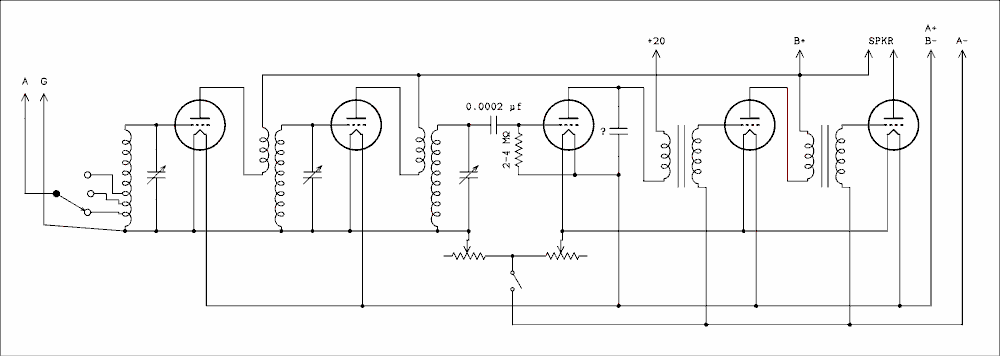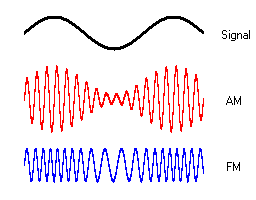



THE HISTORY OF BROADCAST RADIO
The transmission of long distance radio waves started at the end of the 19th century, with the WIRELESS TELEGRAPH, that was used for sending telegrams by Morse Code. Spark-Gap, Arc and HF Alternator Transmitters were used to generate the wireless signals and Crystal Detector Receivers, to receive the Morse Code signals.
It was not possible to transmit voice or music with the spark transmitters. In December 1906, experimental High Frequency Alternator Transmitter modulated by water cooled Carbon Microphone, was used by Frederick James Fessenden (1862-1943) to broadcast voice and music.


AUDION Advertisement

Early TRIODE Tube
The development of the vacuum tube and the AUDION or TRIODE (1906-1910), enabled the generation of a pure radio signal with oscillator circuit . The amplification capabilities of the TRIODE tubes enabled the design of radio transmitters with higher power output. Triode tubes were used in the Audio Signal Amplifier for modulating the voltage feeding the transmitter power tube. This was the first step to start broadcasting voice and music to distant locations by radio.
The RADIO Broadcast era started in 1920 with the first radio stations in the USA. The KDKA station of Westinghouse may be considered as the pioneer broadcasting station, although it was originally licensed for commercial communication purpose.
THE KDKA OPERATING ROOM
Link to a video report about earlier broadcasting by CHARLES HAROLD
and later on the KDKA STORY
AERIOLA Jr. Crystal Receiver
The AERIOLA Junior Crystal Receiver is the first factory built radio receiver. It was Introduced in June 1921 with a pair of headphones and a PERIKON Detector.
Until the Aeriola Jr., only Do-It-Yourself Crystal Sets were available in the market.
Westinghouse manuctured the Aeriola Jr. for RCA, because RCA had no manufacturing facilities in the 1920's.

High power transmitters were required to get a reasonable reception range, with the Crystal Detector Receivers of those days. With the TRIODE amplified detector receivers and later on the TRF (Tuned Radio Frequency) receivers using radio frequency amplifying tubes, the receiving range was increased dramatically.

KENMAN 5, FIVE TUBES TRF RECEIVER (1926)


Further advances in the receiving technology came with the development of the heterodyne and later on the Super-Heterodyne (Superhet) receiver circuit by Edwin Armstrong in 1918. The radio frequency (RF) signal from the antenna is mixed with the frequency of a local oscillator, in the MIXER (or converter) TUBE. The frequency at the output of the MIXER/CONVERTER TUBE is the difference between the received frequency and the local oscillator frequency. The frequency difference is kept fixed by ganging the variable capacitors of the antenna tuning circuit and the local oscillator. The fixed frequency is called Intermediate Frequency (IF), which is amplified by several tube stages with fixed tuned circuits.
During the 1920’s, most of the commercial broadcast radio receivers were Crystal Sets and tube amplified TRF receivers with headphones and loudspeakers. From the end of the 1920’s and the beginning of the 1930’s, almost all the radio receivers were SUPERHETS. Since then, the SUPERHET receiver circuit is used in every receiver. In professional communication receivers, there is a Double Conversion circuitry with two mixers.

RCA VICTOR R-28-P
ONE OF THE FIRST RCA SUPR-HETERODYNE RADIOS, AT THE BEGINNING OF THE 1930's


MODULATION METHODS
The modulation method that was used from the first days of the Broadcast Era is AM (Amplitude Modulation). The AUDIO frequency signal (voice or music), modulates the intensity (amplitude) of the transmitted RF (Radio Frequency), or carrier. A detector stage in the radio receiver is used to separate the AUDIO signal from the RF signal.
The disadvantage of AM method is the static noises that are imposed on the Carrier Envelope. It is not possible to reduce the static noise in AM receivers, without reduction of the audio quality.
To solve the static noise problems, Edwin Armstrong invented a new modulation method, the Frequency Modulation (FM). The AUDIO frequency signal modulates the frequency of the CARRIER Signal. The amplitude of the carrier signal is fixed, but the center frequency of the transmitter is deviated up and down by the sinusoidal waveform of the Audio Signal. Armstrong developed both the transmitter FM MODULATOR circuit and the receiver FM DISCRIMINATOR or detector. The advantage of FM Modulation is very low noise reception, due to the possibility to clip the envelope of the received signal (that contains the noise), while keeping the quality of the audio signal. Another advantage is the much wider frequency response.
STEREOPHONIC-FM broadcasting was introduced by many prime manufacturers, but only the proposed method of Zenith and GE (which were similar), was approved by the FCC in 1961. It was the standard STEREO-FM in the United States and later on became worldwide. The most important requirement in STEREO-FM transmission, is that both right and left channels can be heard on standard MONOPHONIC FM receivers.
QUADRAPHONIC FM broadcast with four channels was introduced by Louis Dorren in 1969. Several prime manufacturers proposed similar optional methods for Quadraphonic FM Broadcast. The QUADRAPLEX system of Dorren was approved as the National Standard for Quadraphonic FM Broadcast in the USA.

THE WAVEFORMS OF THE AUDIO SIGNAL AND HOW THE CARRIER FREQUENCY IS MODULATED IN AM AND FM
MODULATION
TRANSISTOR RADIOS
Portable tube radios operated from two batteries: Filament battery and High Voltage battery. Miniature tubes were used and the running cost was high, due to the expensive batteries. The dimensions of the smallest portable tube radio were quite large and no model could be considered as a POCKET RADIO.


Before the invention of the TRANSISTOR at Bell Laboratories in 1947, there was an extensive use of Germanium Diodes like the popular 1N34. The experience with such semiconductor diodes led William Shockley, John Bardeen and Walter Brattain at Bell Labs to examine the performance and properties of a three element point contact diode. The results proved that the three element semiconductor device can act as an amplifier like the vacuum tube triode.
The new invention was announced to the public in 1948, as a device that can replace the vacuum tubes. The first practical transistors used Germanium as the semiconductor material with POINT CONTACT technology. Later on the JUNCTION CONTACT technology dominated. Silicon semiconductor material was used at the end of the 1950’s to get better grade transistors for operation at higher temperatures.
The first commercial transistors were mainly used in hearing aid units by Raytheon, replacing the sub-miniature vacuum tubes. In 1951, Texas Instruments was licensed by Bell Labs (among others) to use the new transistors technology. Pat Haggerty of TI had a vision that the new transistors would replace many millions of vacuum tubes. He was looking for a high volume product for the consumer market. In 1954 TI decided that the best choice was a portable radio and a budget of 2 million dollars was available for starting the development of a transistorized portable radio, with a target retail price of $50.
Paul Davis led the engineering team that developed the prototypes and in October 1954 the new REGENCY TR-1 All Transistor Pocket Radio was announced by TI. The first production run was 1,500 radios and reached 100,000 units in the coming year.

REGENCY TR-1
The First all Transistor Pocket Radio (1954)


The next model of Regency was TR-1G and later on TR-4, TR-5 and more models. Regency stopped producing transistor radios in 1961. The competitors of Regency (Bulova, Emerson,GE, Zenith, RCA and Rayheon) intruduced their first transistor radios from 1955.
In Japan, the first Transistor Radio was introduced in 1955 by TTCE Corp. It was marketed as SONY TR-55 and was intended for the US market. Another SONY model TR-7 was introduced to the US market, but both had no satisfying marketing results. A new SONY Model TR-63 was introduced with sales of 100,000 units in 1957.
In the coming years, the Japanese electronics industry became the main competitor of the US manufacturers and transistor radios from Japan dominated the world market.
© 2023 by Success Consulting. Proudly created with Wix.com TELECOM MILESTONES Along the History of TELECOM and Electronics Technology
